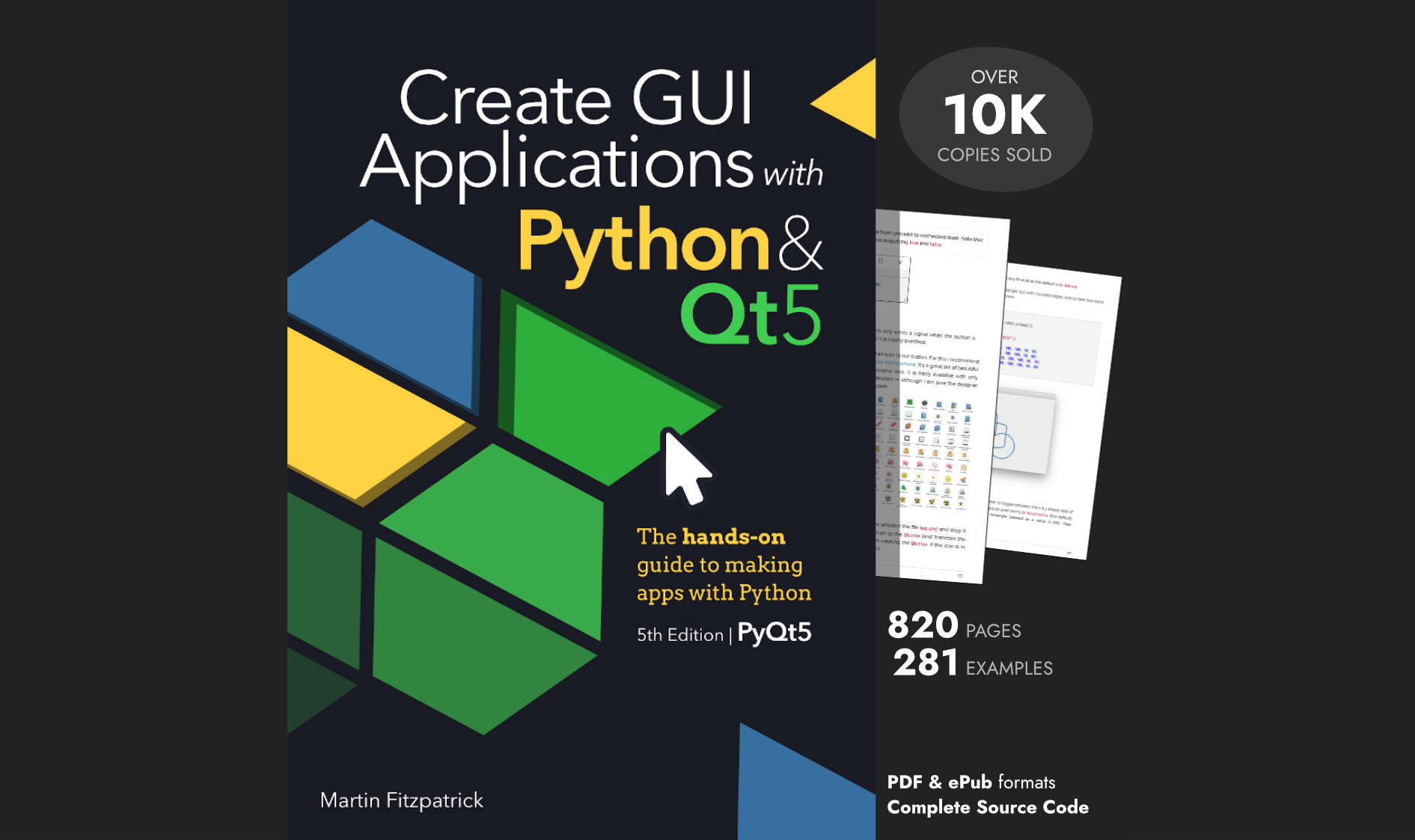luis | 2020-10-02 21:46:29 UTC | #1
I'm going through the "Querying SQL databases with Qt models" chapter of the PySide2 edition of the book. I need something like the "databases\tableview_querymodel.py" sample. And then a button, that should perform something based on the contents of the rows selected by the user from that tableview.
So, how can I get the rows that were selected by the user from that tableview and then iterate through the contents of those selected rows?
Thanks in advance!
luis | 2020-10-01 22:22:36 UTC | #2
I found the answer. On my self.table = QTableView() I need to do this the retrieve the rows selected by the user:
indexes = self.table.selectionModel().selectedRows()
Create GUI Applications with Python & Qt6 by Martin Fitzpatrick — (PyQt6 Edition) The hands-on guide to making apps with Python — Over 10,000 copies sold!
and then for example to print the contents of the 2nd column of the selected rows:
for index in indexes:
print(self.table.model().data(self.table.model().index(index.row(), 1)))
martin | 2020-10-03 12:03:28 UTC | #3
Hey @luis yep that will do it. I'd take a reference to the model object first just to simplify the code a bit
model = self.table.model()
for index in indexes:
print(model.data(model.index(index.row(), 1)))
~~Note, that in your .data method the second param 1 is Qt.DecorationRole -- not sure if this is what you intended? If you want to get the content you would use Qt.DisplayRole (which == 0) (see roles enum in the documentation).~~ Ignore this my eyes were wonky with the brackets.
Also .... I was looking at the selectedRows method though and noticed that it actually accepts a parameter column which (slightly confusingly) is the value it uses for the column in the returned indexes.
Since you want the values in column 2, you can simplify a bit by passing that column number to selectedRows directly... it then returns the exact indexes you want.
indexes = self.table.selectionModel().selectedRows(column=2)
model = self.table.model()
role = Qt.DisplayRole # or Qt.DecorationRole
for index in indexes:
print(model.data(index, role))
luis | 2020-10-02 14:03:16 UTC | #4
Much cleaner! Thanks for the hints.
edit: and in my code, the 1 in index.row(), 1 is needed to access the data of the second column. 0 gives me the 1st column, 2 would be the 3rd and so on.
martin | 2020-10-02 21:45:49 UTC | #5
Great, glad it helped! I think this is a good candidate to add tutorial about, common to want to find what is selected in a table.
[quote="luis, post:4, topic:495"] edit: and in my code, the 1 in index.row(), 1 is needed to access the data of the second column. 0 gives me the 1st column, 2 would be the 3rd and so on. [/quote]
Purchasing Power Parity
Developers in [[ country ]] get [[ discount.discount_pc ]]% OFF on all books & courses with code [[ discount.coupon_code ]]Ha, quite right -- got confused among all the brackets :D
Max_Fritzler | 2021-05-01 21:15:17 UTC | #7
I would really appreciate a tutorial on this.
Also, you can apparently do something like: "self.myQSQLTableModel.record(integer).value("myFieldName")
I'm trying to use this because it allows reference by name. I hate using positional reference to a sql record, because it breaks if I find myself having to add or delete fields. This apparently acts through the model, whereas your solution Martin acts through the TableView. Since I'm a newbie with QT, I have not yet figured out when I should be using the model, and when the view.
thanks
Max_Fritzler | 2021-05-02 10:45:15 UTC | #8
and of course, Martin, in your example I can use fieldIndex to get the value by name, like this: indexes = self.utterancesTable.selectionModel().selectedRows(column=self.model.fieldIndex("UID"))
Maxim_Doucet | 2021-07-16 12:59:35 UTC | #9
You can also get the same result with:
indexes = self.table.selectionModel().selectedRows()
for index in indexes:
print(index.child(index.row(), 1).data())
(no need to retrieve the model, the index is enough)
Create GUI Applications with Python & Qt6 by Martin Fitzpatrick — (PySide6 Edition) The hands-on guide to making apps with Python — Over 10,000 copies sold!

